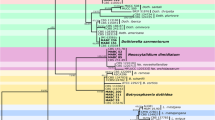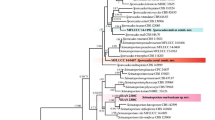Abstract
The diversity of Botryosphaeriaceae species associated with “Botryosphaeria dieback” of grapevine was investigated in 18 vineyards in Sardinia, Italy. Lasiodiplodia isolates obtained from different woody hosts including holm oak, sweet orange and broom bush in Italy, Algeria and Tunisia were also characterized. Morphological and cultural characteristics as well as ITS and EF1-α sequence data were used to identify the fungal isolates. Forty-eight botryosphaeriaceous isolates were obtained from 113 symptomatic grapevine samples, from which ten species were identified. Diplodia seriata was the dominant species (25 % of isolates), followed by Neofusicoccum parvum (21.7 %). Two species, Diplodia olivarum and D. africana are reported for the first time on grapevine. In addition, two new species namely Lasiodiplodia mediterranea sp. nov. from grapevine, holm oak and sweet orange and Lasiodiplodia exigua sp. nov. from broom bush are described. In artificial inoculation experiments conducted on excised green grapevine shoots and lignified canes as well as holm oak seedlings, L. mediterranea was shown to be an aggressive pathogen.




Similar content being viewed by others
References
Abdollahzadeh J, Javadi A, Mohammadi-Goltapeh E, Zare R, Phillips AJL (2010) Phylogeny and morphology of four new species of Lasiodiplodia from Iran. Persoonia 25:1–10
Altschul SF, Gish W, Miller W, Myers EW, Lipman DJ (1990) Basic local alignment search tool. J Mol Biol 215:403–410
Alves A, Crous PW, Correia A, Phillips AJL (2008) Morphological and molecular data reveal cryptic species in Lasiodiplodia theobromae. Fungal Divers 28:1–13
Aroca A, Raposo R, Gramaje D, Armengol J, Martos S, Luque J (2008) First report of Lasiodiplodia theobromae on rootstock mother grapevines in Spain. Plant Dis 92:832
Auger J, Esterio M, Ricke G, Pérez I (2004) Black dead arm and basal canker of Vitis vinifera cv. Red globe caused by Botryosphaeria obtusa in Chile. Plant Dis 88:1286
Begoude BAD, Slippers B, Wingfield MJ, Roux J (2010) Botryosphaeriaceae associated with Terminalia catappa in Cameroon, South Africa and Madagascar. Mycol Prog 9:101–123
Burgess TI, Barber PA, Mohali S, Pegg G, de Beer W, Wingfield MJ (2006) Three new Lasiodiplodia spp. from the tropics, recognized based on DNA sequence comparisons and morphology. Mycologia 98:423–435
Burruano S, Mondello V, Conigliaro G, Alfonzo A, Spagnolo A, Mugnai L (2008) Grapevine decline in Italy caused by Lasiodiplodia theobromae. Phytopathol Mediterr 47:132–136
Correia KC, Câmara MPS, Barbosa MAG, Sales R, Agustí-Brisach C, Gramaje D, León M, García-Jiménez J, Abad-Campos P, Armengol J, Michereff SJ (2013) Fungal trunk pathogens associated with table grape decline in Northeastern Brazil. Phytopathol Mediterr 52(2):380–387
Crous PW, Gams W, Stalpers JA, Robert V, Stegehuis G (2004) MycoBank: an online initiative to launch mycology into the 21st century. Stud Mycol 50:19–22
Damm U, Crous PW, Fourie PH (2007) Botryosphaeriaceae as potential pathogens of Prunus in South Africa, with descriptions of Diplodia africana and Lasiodiplodia plurivora sp. nov. Mycologia 99:664–680
Deidda A, Linaldeddu BT, Scanu B, Serra G, Serra S (2012) Fungal pathogens associated with grapevine trunk diseases in Sardinia (Italy). Phytopathol Mediterr 51(2):423
Inderbitzin P, Harkness J, Tiurgeon BG, Berbee ML (2005) Lateral transfer of mating system in Stemphylium. Proc Natl Acad Sci U S A 102:11390–11395
Inderbitzin P, Bostock RM, Trouillas FP, Michailides TJ (2010) A six-locus phylogeny reveals high species diversity in Botryosphaeriaceae from California almond. Mycologia 102:1350–1368
Ismail AM, Cirvilleri G, Polizzi G, Crous PW, Groenewald JZ, Lombard L (2012) Lasiodiplodia species associated with dieback disease of mango (Mangifera indica) in Egypt. Australas Plant Pathol 41:649–660
Larignon P, Fulchic R, Cere L, Dubos B (2001) Observations of Black dead arm in French vineyards. Phytophathol Mediterr 40:336–342
Linaldeddu BT, Luque J, Franceschini A (2006) Occurrence of Botryosphaeria obtusa in declining cork oak trees in Italy. J Plant Pathol 88:66
Linaldeddu BT, Franceschini A, Luque J, Phillips AJL (2007) First report of canker disease caused by Botryosphaeria parva on cork oak trees in Italy. Plant Dis 91:324
Linaldeddu BT, Scanu B, Schiaffino A, Serra S (2010) First report of Neofusicoccum australe associated with grapevine cordon dieback in Italy. Phytopathol Mediterr 49(3):417–420
Linaldeddu BT, Scanu B, Maddau L, Franceschini A (2011) Diplodia africana causing dieback disease on Juniperus phoenicea: a new host and first report in the northern hemisphere. Phytopathol Mediterr 50(3):473–477
Linaldeddu BT, Franceschini A, Alves A, Phillips AJL (2013) Diplodia quercivora sp. nov.: a new species of Diplodia found on declining Quercus canariensis trees in Tunisia. Mycologia 105:1266–1274
Linaldeddu BT, Scanu B, Maddau L, Franceschini A (2014) Diplodia corticola and Phytophthora cinnamomi: the main pathogens involved in holm oak decline on Caprera Island (Italy). For Pathol 44(3):191–200
Liu JK, Phookamsak R, Mingkhuan M, Wikee S, Li YM, Ariyawansha H, Boonmee S, Chomnunti P, Dai DQ, Bhat JD, Romero AI, Zhuang WY, Monkai J, Gareth Jones EB, Chukeatirote E, Ko Ko TW, Zhao YC, Wang Y, Hyde KD (2012) Towards a natural classification of Botryosphaeriales. Fungal Divers 57:149–210
Luque J, Martos S, Aroca A, Raposo R, Garcia-Figueres F (2009) Symptoms and fungi associated with declining mature grapevine plants in northeast Spain. J Plant Pathol 91:381–390
Machado AR, Pinho DB, Pereira OL (2014) Phylogeny, identification and pathogenicity of the Botryosphaeriaceae associated with collar and root rot of the biofuel plant Jatropha curcas in Brazil, with a description of new species of Lasiodiplodia. Fungal Divers. doi:10.1007/s13225-013-0274-1
Mohali S, Burgess TI, Wingfield MJ (2005) Diversity and host association of the tropical tree endophyte Lasiodiplodia theobromae revealed using simple sequence repeat markers. For Pathol 35:385–396
Mohammadi H, Gramaje D, Banihashemi Z, Armengol J (2013) Characterization of Diplodia seriata and Neofusicoccum parvum associated with grapevine decline in Iran. J Agric Sci Technol 15:603–616
Mondello V, Lo Piccolo S, Conigliaro G, Alfonzo A, Torta L, Burruano S (2013) First report of Neofusiccoccum vitifusiforme and presence of other Botryosphaeriaceae species associated with Botryosphaeria dieback of grapevine in Sicily (Italy). Phytopathol Mediterr 52:388–396
Morales A, Latorre BA, Piontelli E, Besoain X (2012) Botryosphaeriaceae species affecting table grapes vineyards in Chile and cultivar susceptibility. Cienc Investig Agrar 39:445–458
Page RD (1996) TreeView: an application to display phylogenetic trees on personal computers. Comput Appl Biosci 12:357–358
Pavlic D, Slippers B, Coutinho TA, Gryzenhout M, Wingfield MJ (2004) Lasiodiplodia gonubiensis sp. nov., a new Botryosphaeria anamorph from native Syzygium cordatum in South Africa. Stud Mycol 50:313–322
Pavlic D, Wingfield MJ, Barber P, Slippers B, Harder GES, Burgess TI (2008) Seven new species of the Botryosphaeriaceae from baobab and other native trees in Western Australia. Mycologia 100:851–866
Phillips AJL (1998) Botryosphaeria dothidea and other fungi associated with excoriose and dieback of grapevines in Portugal. J Phytopathol 146:327–332
Phillips AJL (2002) Botryosphaeria species associated with diseases of grapevines in Portugal. Phytopathol Mediterr 41:3–18
Phillips AJL, Alves A, Pennycook SR, Johnston PR, Ramaley A, Akulov A, Crous PW (2008) Resolving the phylogenetic and taxonomic status of dark-spored teleomorph genera in the Botryosphaeriaceae. Persoonia 21:29–55
Phillips AJL, Alves A, Abdollahzadeh J, Slippers B, Wingfield MJ, Groenewald JZ, Crous PW (2013) The Botryosphaeriaceae: genera and species known from culture. Stud Mycol 76:51–167
Pitt WM, Huang R, Steel CC, Savocchia S (2010) Identification, distribution and current taxonomy of Botryosphaeriaceae species associated with grapevine decline in New South Wales and South Australia. Aust J Grape Wine R 16:258–271
Rannala B, Yang Z (1996) Probability distribution of molecular evolutionary trees: a new method of phylogenetic inference. J Mol Evol 43:304–311
Rodriguez F, Oliver JF, Marin A, Medina JR (1990) The general stochastic model of nucleotide substitutions. J Theor Biol 142:485–501
Ronquist FR, Huelsenbeck JP (2003) MrBayes3: Bayesian phylogenetic inference under mixed models. Bioinformatics 19:1572–1574
Serra S, Mannoni MA, Ligios V (2010) Il mal dell’esca della vite in Sardegna. In: Il mal dell’esca della vite. Interventi di Ricerca e Sperimentazione per il Contenimento della Malattia. Progetto Mesvit. Arsia Toscana, Firenze, Italy, 165–170
Stamatakis A (2006) RAxML-VII-HPC: maximum likelihood-based phylogenetic analyses with thousands of taxa and mixed models. Bioinformatics 22:2688–2690
Stamatakis A, Hoover P, Rougemont J (2008) A rapid bootstrap algorithm for the RAxML-VI-HPC web servers. Syst Biol 57:758–771
Taylor A, Hardy GESTJ, Wood P, Burgess T (2005) Identification and pathogenicity of Botryosphaeria species associated with grapevine decline in Western Australia. Australas Plant Pathol 34:187–195
Thompson JD, Gibson TJ, Plewniak F, Jeanmougin F, Higgins DG (1997) The ClustalX windows interface: flexible strategies for multiple sequence alignment aided by quality analysis tools. Nucleic Acids Res 25:4876–4882
Úrbez-Torres JR (2011) The status of Botryosphaeriaceae species infecting grapevines. Phytopathol Mediterr 50:S5–S45
Úrbez-Torres JR, Gubler WD (2009) Pathogenicity of Botryosphaeriaceae spp. isolated from grapevine cankers in California. Plant Dis 93:584–592
Úrbez-Torres JR, Leavitt GM, Voegel TM, Gubler WD (2006) Identification and distribution of Botryosphaeria spp. associated with grapevine cankers in California. Plant Dis 90:1490–1503
Úrbez-Torres JR, Peduto F, Striegler RK, Urrea-Romero KE, Rupe JC, Cartwright RD, Gubler WD (2012) Characterization of fungal pathogens associated with grapevine trunk diseases in Arkansas and Missouri. Fungal Divers 52:169–189
van Niekerk JM, Crous PW, Groenewald JZ, Fourie PH, Halleen F (2004) DNA phylogeny, morphology and pathogenicity of Botryosphaeria species on grapevines. Mycologia 96:781–798
White TJ, Bruns T, Lee S, Taylor J (1990) Amplified and direct sequencing of fungal ribosomal RNA genes for phylogenies. In: Innis MA, Gelfand DH, Sninsky JJ, White TJ (eds) PCR protocols: A guide to methods and applications. Academic, San Diego, pp 315–322
Yan JY, Xie Y, Zhang W, Wang Y, Liu JK, Hyde KD, Seem RC, Zhang GZ, Wang ZY, Yao SW, Bai XJ, Dissanayake AJ, Peng YL, Li XH (2013) Species of Botryosphaeriaceae involved in grapevine dieback in China. Fungal Divers 61:221–236
Acknowledgments
Antonio Deidda and Bruno Scanu gratefully acknowledge Sardinia Regional Government for the financial support of the PhD scholarship and research grant, respectively (P.O.R. Sardegna F.S.E. Operational Programme of the Autonomous Region of Sardinia, European Social Fund 2007–2013 - Axis IV Human Resources, Objective l.3, Line of Activity l.3.1.).
Author information
Authors and Affiliations
Corresponding author
Rights and permissions
About this article
Cite this article
Linaldeddu, B.T., Deidda, A., Scanu, B. et al. Diversity of Botryosphaeriaceae species associated with grapevine and other woody hosts in Italy, Algeria and Tunisia, with descriptions of Lasiodiplodia exigua and Lasiodiplodia mediterranea sp. nov. Fungal Diversity 71, 201–214 (2015). https://doi.org/10.1007/s13225-014-0301-x
Received:
Accepted:
Published:
Issue Date:
DOI: https://doi.org/10.1007/s13225-014-0301-x




